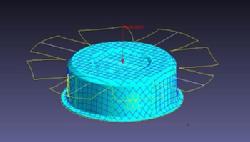Ultra Lightweight Race Wheel
This project from WMG's Lightweighting research team aimed to assess the feasibility of manufacturing a race wheel from carbon fibre for a Caterham sports car.
Typical wheel materials are steel, aluminium and magnesium. Carbon composites offer potential weight savings of 60% compared to these materials. Carbon fibre’s high specific properties, high environmental resistance and excellent fatigue resistance make it an ideal material to reduce the mass of vehicle components, thereby reducing vehicle emissions.
Objective:
The objective of this project was to design, optimise and manufacture a lightweight 13” x 6” carbon fibre racing wheel rim for use on a Caterham sports car. To ensure the wheel was as robust as possible, the worst case design parameters were chosen from the range of Caterham’s available which accept a 13” x 6” wheel rim (Academy, Supersport and R500 Superlight models). The wheel had a two-piece split rim design.
Catia V5 was used to design the wheel as a surface model. A surface mesh was then exported into the composite optimisation software, Genesis. Optimisation of the wheel was conducted in Genesis by subjecting the rim to a  cornering force, torque, centripetal force and tyre pressure calculated from the design parameters. The optimisation took account of the carbon fibre properties, number of plies in the layup and ply orientation. Topological and stress-strain finite element analysis results were used to guide the development of the wheel geometry. The images to the right show the development from version 1 to version 6 of the wheel design (click to enlarge).
cornering force, torque, centripetal force and tyre pressure calculated from the design parameters. The optimisation took account of the carbon fibre properties, number of plies in the layup and ply orientation. Topological and stress-strain finite element analysis results were used to guide the development of the wheel geometry. The images to the right show the development from version 1 to version 6 of the wheel design (click to enlarge).
Laminate Tools software was used to model the draping of carbon fibre onto the moulds. It identifies areas of high shear strain in the woven carbon fibre that will prevent it from draping correctly. The layup can then be changed to incorporate darts or multiple smaller plies. The draped parts then underwent a vacuum bagging process to cure the carbon fibre. The resultant front and rear rims were bonded together with a one part epoxy to create the assembled wheel rim.
Outcome:
This project demonstrated the use of modelling and optimisation software in the successful design and development of a complex structural carbon fibre component. The manufactured wheel rim weighed 1.2 kg, a mass reduction of 76% in comparison to an equivalent forged aluminium race wheel. This weight saving is a result of the use of carbon fibre and the implementation of composite orientated optimisation software.


